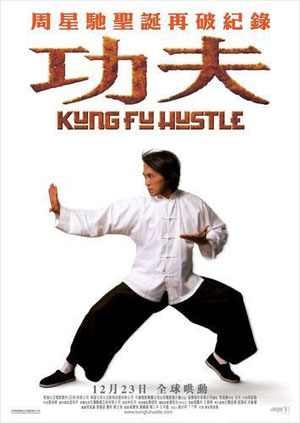KUNG-FU HUSTLE
Director Stephen Chow
Writers Tsang Kan Cheong, Stephen Chow
 Kung-Fu Hustle is a giddy, inventive mix of styles and influences. A pinch of wire-fu here, a dash of Bugs Bunny there, add a touch of the recklessly bizarre, and the result is something perhaps not wholly new, but always entertaining.
Kung-Fu Hustle is a giddy, inventive mix of styles and influences. A pinch of wire-fu here, a dash of Bugs Bunny there, add a touch of the recklessly bizarre, and the result is something perhaps not wholly new, but always entertaining.
The film follows dual plots that frequently intersect. In one, a ruthless, bowtie wearing, fancy-dancing, axe-wielding cabal known improbably as the Axe Gang threatens a lower class community. Luckily, several of the tenants—including a memorable, effeminate tailor and a man who beats people with uncooked noodles—are skilled in martial arts. Which is nice, because in the struggle between Regular Man and Flying Axe, the latter is generally a 60-1 favorite. The other story features a hard-luck drifter who dreams of joining the Axe Gang as a way to make something of himself, overcoming a childhood trauma—one that involved an act of kindness gone horribly wrong—in the process.
A dry description of the plot almost does Kung-Fu Hustle a disservice, as it is in the presentation that the film scores most of its points. Stephen Chow, who not only stars in the movie but also directs from a screenplay he co-wrote, infuses the proceedings with wit and impeccable comic timing that is in the very best tradition of classic cartoons such as Looney Tunes. Homage runs rampant—a hysterical sequence inspired by the Road Runner and Wile E. Coyote springs most readily to mind. Old men and little boys have steroid-fueled bodies. Someone falls from a three-story window and is strangely unharmed. Murderous thugs participate in a big-time dance number. People are smacked around with impunity. Kung-Fu Hustle is, in fact, a more fitting addition to the legacy of cartoon violence than some of its originator’s recent efforts (if you haven’t Googled “Loonatix” yet, do so and share the pain of many others).
As the film moves into its third act, much of the humor is set aside as storylines begin to converge, and a pair of plot-driven set pieces dominates. Yuen Wo-ping (whose past handiwork includes Crouching Tiger, Hidden Dragon, Kill Bill and the Matrix trilogy) choreographs the action throughout, and it is up to his customary standard. That standard is what saves the movie as it digresses away from slapstick; in the hands of a lesser fight director, one might have felt the loss. But Wo-ping’s choreography is a mix of beauty and brutality that keeps things exciting and engrossing, if less innovative than it’s first two-thirds. Kung-Fu Hustle may ultimately be a film of two minds, but both minds are more than sharp enough to keep people entertained.
Still, two-thirds of a unique film is two-thirds more unique than more other films, so Kung-Fu Hustle is ahead of the curve. It’s understandable why it was given a reasonably wide release. Its unique influences and comedic tone will appeal to kung-fu neophytes, and casual fans of the genre may find it a welcome tonic to the more serious and ethereal period offerings of the last few years.
Ryan Landau can fly! He currently nests in the eastern U.S., but come this November will migrate south to Aruba Key West. Also, he is a werewolf.
